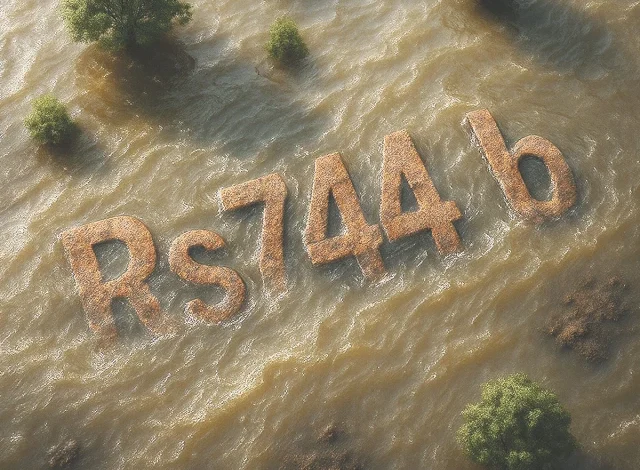IMF assistance for flood damages is requested.

Pakistan told the International Monetary Fund (IMF) on Wednesday that floods had cost its economy Rs744 billion, with 60% of the damage coming from the agricultural sector. The country once more requested that these losses be adjusted against the program’s goals.
Finance Minister Muhammad Aurangzeb acknowledged that the review talks with the international lender came to a close on Wednesday, and the IMF has been provided with the preliminary damage assessment. Securing two loan tranches totaling around $1.2 billion under distinct credit programs was the goal of the negotiations.
According to Aurangzeb, the Memorandum for Economic and Financial Policies (MEFP) had been provided by the IMF, and following additional negotiations, the Staff-Level Agreement for finishing the second review would be made public. Both parties have agreed on a package of policy texts known as the MEFP. “There has been a broader consensus with the IMF,” the finance minister stated in a casual conversation with reporters from two media sites outside the Q Block.
As the negotiations came to an end, according to sources, the main topic of conversation was how to balance the effects of the floods with the program’s primary budget surplus and provincial cash surplus goals. They stated that the prime minister was also briefed on this topic by the finance ministry.
The IMF had previously suggested about Rs500 billion in budgetary modifications to mitigate the effects of the floods, and it had set the main budget surplus target at Rs3.1 trillion. According to sources, the finance ministry requested that the IMF permit revisions against the target up to the actual damage amount.
Preliminary data provided to the IMF indicates that the economy lost Rs744 billion. Economic growth is now expected to stay at 3.5% after accounting for these losses, as opposed to the 4.2% annual forecast. The updated growth estimate is still roughly 1% higher than the 2.6% recent World Bank estimate, which also included flood damage.
According to preliminary estimates, Punjab lost Rs632 billion of the Rs744 billion. Khyber-Pakhtunkhwa (K-P) reported losses of Rs51.3 billion, followed by Sindh with Rs32.2 billion, K-P with another Rs12.6 billion, and Balochistan with Rs6.8 billion.
6.5 million people were forced to evacuate as a result of flash rainfall in the country’s upper regions and flooding in three rivers that flooded vast areas.
The initial estimate of Rs370 billion that was given to the IMF has been doubled to Rs744 billion in damages.
According to details, the agriculture industry lost over 60% of the total, or Rs439 billion. Nearly all of these have to do with crops. Consequently, the 4.5% target for agriculture growth has been lowered to 3%. Against the goal of 5.4%, growth in the agriculture subsector is predicted to drop below 1%. 22,841 cattle and 3.3 million acres of crops were impacted.
About one-third of the cotton crop was damaged; preliminary estimates put the yield at 7.2 million bales, a decrease of up to 3.4 million bales.
With an anticipated production of 8.9 million tonnes, authorities calculated that 12.6% of the rice crop was damaged, resulting in a loss of 600,000 to 1.2 million tonnes. With losses ranging from 1.3 million to 3.3 million tonnes, or 4% of budget predictions, sugarcane production has been reduced to 79 million tonnes. With an output cap of 9.2 million tonnes, maize production is expected to drop by 13%.
According to the evaluation, the industrial sector lost Rs48 billion, and its yearly growth rate was marginally reduced to 4.1%.
With an estimated loss of Rs257 billion, the services sector is predicted to have had the second-highest losses, lowering its growth projection by 0.4% to 3.6%. The transport and storage subsector of services suffered the largest loss, amounting to Rs150 billion, which nearly halved its growth rate to 1.9%. The wholesale and trade industries lost Rs40 billion, while real estate operations lost Rs55 billion.
According to preliminary estimates, 866 water infrastructure systems were washed away, 790 bridges were destroyed, and 229,763 homes were damaged. Approximately 2,811 kilometers of highways sustained damage.
There were 213,097 damaged homes in Punjab alone, 6,370 in Balochistan, 3,332 in Sindh, 3,222 in K-P, 2,417 in Azad Kashmir, and 1,260 in Gilgit-Baltistan. In Punjab, 5,467 animals died and 462 bridges and 1,216 kilometers of roads were devastated.
Nationwide, 1,037 fatalities and 1,067 injuries were recorded. K-P had the most deaths (509), followed by Punjab (322), Sindh (90), Balochistan (38), Azad Jammu and Kashmir (31), Gilgit-Baltistan (31), and Islamabad (9).
Additionally, 1,297 commercial stores and eight mines were impacted by floodwaters. Approximately 129 governmental buildings, 243 medical facilities, and 2,267 educational institutions sustained damage. 6.5 million people were impacted by the floods, which interrupted daily life in 70 districts. Four million of them were moved to safer places.